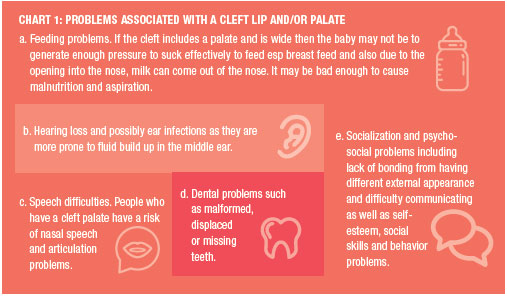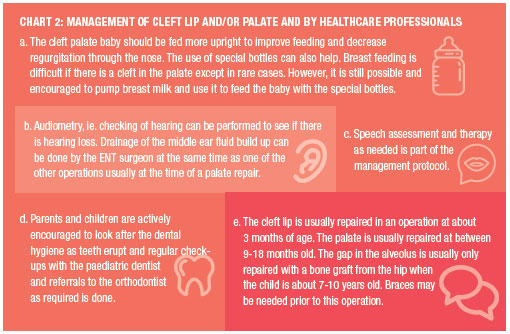Introduction to Cleft Lips and Palates
07 May 2019
Cleft Lip and Palate (CLP) is a deformity caused by abnormal facial development during pregnancy. It can be part of a diverse group of complex congenital anomalies.
It can be associated with syndromes or it can occur on its own.
It can affect just one side, ie. unilateral or be on both sides, ie. bilateral. It can also just affect part of the lip, ie. incomplete or the whole lip including the floor of the nose, ie. complete.
It can range from just a mild lip notch, ie. a microformed cleft, or just a cleft of the soft palate, to a full blown lip, palate and alveolus (gums) cleft with all the associated problems such as hearing, speech, dental and facial growth.
Hence an inter-disciplinary approach is required to care for a cleft child.
The incidence of CLP is 1:1000 in Caucasians and 1:500 in Asians.
The cause of a cleft in a baby is unknown but is most probably a combination of genetic and environmental factors. That is if there is a family history of a cleft, then the chances are higher of having a cleft child. Environmental factors include certain drugs during pregnancy and smoking and alcohol. There are many problems associated with a cleft lip and/or palate.
Problems Associated with a Cleft Lip and/or Palate
a. Feeding problems.
If the cleft includes a palate and is wide then the baby may not be to generate enough pressure to suck effectively to feed esp breast feed and also due to the opening into the nose, milk can come out of the nose. It may be bad enough to cause malnutrition and aspiration.
b. Hearing loss and possibly ear infections
as they are more prone to fluid build up in the middle ear.
c. Speech difficulties.
People who have a cleft palate have a risk of nasal speech and articulation problems.
d. Dental problems
such as malformed, displaced or missing teeth.
e. Socialization and psycho- social problems
including lack of bonding from having different external appearance and difficulty communicating as well as self- esteem, social skills and behavior problems.

These problems are managed by a team of healthcare professionals which may include a plastic surgeon, a maxillofacial surgeon, a paediatrician, a paediatric dentist, an ENT surgeon, an orthodontist, a speech therapist, a social worker, a geneticist and a nurse coordinator. (see Chart 2 below). Most of the cleft children who have their repair done timely with minimal scars will lead normal social lives with minimal psychological problems. However, it is likely that these children do have problems especially during adolescence where appearance and ‘being normal’ is viewed as being the most important factor. Other operations may be necessary such as a pharyngoplasty to better improve speech and orthognathic surgery to correct any skeletal deformity of the jaws but these especially the latter are done at a much later date when the cleft patient is nearly adult. Some smaller touch up operations to improve outcomes such as a lip revision or a nose revision may be necessary.
Hence treatment begins in infancy and continues up to adulthood. It is best that these children are followed up regularly, at least once a year to ensure continuity of care and to avoid missing any problems that may be prevented or remedied early.
Restorative treatments and psychological counselling can help a cleft individual feel better about themselves. Interaction with other cleft persons in patient-parent groups may also be beneficial.

Management of Cleft Lip and/or Palate by Healthcare Professionals
a. The deft palate baby should be fed more upright to improve feeding and decrease regurgitation through the nose. The use of special bottles can also help. Breastfeeding is difficult if there is a cleft in the palate, except in rare cases. However, it is still possible and encouraged to pump breast milk and use it to feed the baby with the special bottles.
b. Audiometry, ie, checking of hearing, can be performed to see if there is hearing loss. Drainage of the middle ear fluid build up can be done by the ENT surgeon at the same time as one of the other operations usually at the time of a palate repair.
c. Speech assessment and therapy as needed is part of the management protocol.
d. Parents and children are actively encouraged to look after the dental hygiene as teeth erupt and regular check-ups with the paediatric dentist and referrals to the orthodontist as required is done.
e. The cleft lip is usually repaired in an operation at about 3 months of age. The palate is usually repaired between 9 and 18 months old. The gap in the alveolus is usually only repaired with a bone graft from the hip when the child is about 7–10 years old. Braces may be needed prior to this operation.






